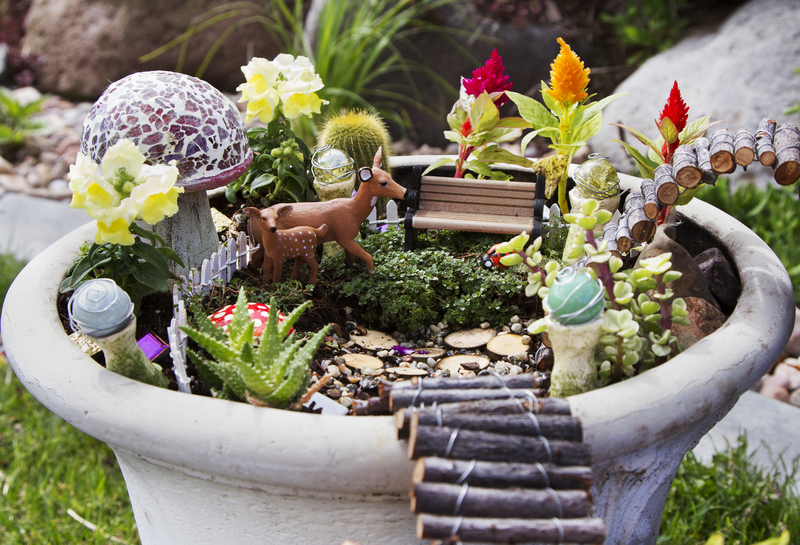Hedge Trimming Techniques for a Sculpted Landscape
Posted on 14/08/2025
Hedge Trimming Techniques for a Sculpted Landscape
Transforming your garden with artfully sculpted hedges requires both skill and knowledge. Whether you own a sprawling estate or a compact backyard, mastering hedge trimming techniques can elevate your landscape design. In this comprehensive guide, we'll explore the best practices to achieve a well-manicured, sculpted look for your hedges, covering tools, timing, trimming methods, maintenance routines, and creative ideas.

Understanding the Importance of Proper Hedge Trimming
Before diving into the practical steps, it's important to understand why hedge trimming is crucial for a sculpted landscape:
- Healthier Plants: Regular trimming removes dead or diseased wood, promoting airflow and reducing the risk of disease.
- Shape Control: Targeted cuts guide the growth of your hedge, allowing you to sculpt impressive shapes or keep sharply defined edges.
- Enhanced Privacy and Security: Well-maintained hedges provide robust privacy screens and natural boundaries.
- Improved Curb Appeal: A carefully shaped hedge adds elegance and structure to your garden, increasing your home's visual charm.
Choosing the Right Tools for Hedge Trimming
Effective hedge sculpting begins with having the proper tools. Here's what you need:
Manual Tools
- Hedge Shears: Best for precise cuts and shaping small to medium hedges. Choose shears with sharp, high-quality blades and comfortable grips.
- Pruning Loppers: Ideal for cutting thicker branches and cleaning up interior growth.
- Hand Pruners: Useful for fine detail work, especially when forming topiary or intricate shapes.
Power Tools
- Electric or Cordless Hedge Trimmers: Perfect for larger hedges, these speed up the process and ensure even cuts.
- Pole Trimmers: Let you reach tall or wide hedges safely without ladders.
Supplementary Tools
- Measuring Tape and Stakes: For marking straight lines or geometric shapes.
- String Lines: Achieve level, even cuts along the top and sides of your hedges.
- Personal Protective Equipment: Safety goggles, gloves, and ear protection are strongly recommended.
When to Trim Your Hedges
Optimal hedge trimming depends on the species and the look you want:
- Evergreen Hedges: Early spring or late summer, depending on growth habit. Avoid heavy pruning in winter to prevent cold damage.
- Deciduous Hedges: Late winter or very early spring before new growth starts.
- Flowering Hedges: Prune after flowering to maintain shape without sacrificing blooms.
Tip: Avoid trimming during hot, dry spells or when plants are under drought stress, as pruning can shock the plants.
Mastering Basic Hedge Trimming Techniques
The A-Shape (Tapered Sides)
The 'A-shape' is a foundational hedge cutting technique for maintaining healthy, well-lit hedges.
- Widest at the base and narrower at the top, allowing sunlight to reach all foliage.
- Use a string as a guide to keep the sides at a consistent angle.
- Make sure the top remains level for a uniform appearance.
Flat-Top Hedges
- Mark the desired height with stakes and string.
- Trim the top first, then the sides.
- Use long, steady strokes, stepping back frequently to inspect for uniformity.
Rounded or Curved Shapes
- Perfect for more informal gardens or when integrating hedges into natural landscapes.
- Use hedge shears for freehand curves, maintaining symmetry on both sides.
Topiary Artistry
Advanced sculpted hedge designs--animals, spirals, geometric forms--require patience and practice:
- Begin with simple shapes like balls or cubes.
- Use wire frames as a guide for complex topiaries.
- Trim little by little, removing small amounts at a time to correct any mistakes easily.
Step-by-Step Guide to Sculpting Your Hedges
Preparation
- Clean and sharpen all tools to ensure smooth, precise cuts.
- Remove any debris or weeds around the base of your hedge.
- Set up guides (stakes, strings, or frames) as needed.
Trimming Process
- Start at the Base: Begin with the lower sides, moving upward--this avoids debris from fallen clippings getting in your way.
- Work Gradually: Remove small amounts, observing the overall shape as you go.
- Check Regularly: Step back frequently to view from multiple angles, ensuring symmetry and smooth lines.
- Shape the Top: Once the sides are finished, trim the top, using a string or board as a leveling guide.
- Finishing Touches: Use hand pruners to clean up missed branches, correct minor imperfections, and tidy up the edges.
Advanced Hedge Trimming Techniques for Dramatic Landscapes
Layered Hedges
Create a visually dynamic landscape by layering hedges of different heights and textures:
- Begin with the largest hedge at the back, working forward with progressively shorter hedges.
- Use contrasting foliage colors and forms for interest.
Espaliered Hedges
Espalier is a technique where hedges are trained to grow flat against a wall or fence in decorative patterns:
- Use frames or wires to guide growth.
- Regular, careful pruning is needed to maintain designs.
Naturalistic and Cloud Pruning
- Cloud pruning (Niwaki) creates rounded, cloud-like shapes for a more organic, whimsical look.
- This style is perfect for Asian-inspired gardens or minimalist landscapes.
Maintaining Your Sculpted Hedges
Regular maintenance is critical to keep your trimmed hedges looking sharp and healthy.
Seasonal Upkeep
- Spring: Remove winter damage and shape new growth.
- Summer: Light trims maintain sharp lines and tidy up any overgrowth.
- Autumn: Prepare for winter by removing damaged or diseased stems.
- Winter: Minimal maintenance except for deciduous hedges during dormancy.
Fertilization and Watering
- Feed hedges with a balanced, slow-release fertilizer at least once a year to promote lush growth.
- Keep soil moist, especially after heavy pruning sessions.
Pest and Disease Management
- Inspect for common issues like spider mites, aphids, or fungal diseases.
- Remove affected branches promptly and treat with organic or chemical solutions as necessary.
Common Mistakes in Hedge Trimming and How to Avoid Them
- Overcutting: Removing too much at once can stress plants and lead to bare patches. Always trim in small increments.
- Neglecting the Base: Not tapering the hedge can result in shaded, thin lower branches. Always make the base wider than the top.
- Dull Tools: Dull blades tear and damage branches, leaving hedges susceptible to disease. Sharpen tools regularly.
- Ignoring Plant Species: Each plant type has unique growth habits. Learn about your hedge species for best trimming results.
- Poor Timing: Trimming at the wrong season can damage plants and reduce flowering. Follow recommended schedules for your hedge type.
Creative Ideas for Sculpted Hedge Designs
Geometric Patterns
- Try squares, rectangles, balls, or pyramids for crisp, modern elegance.
- Use measuring tools to keep lines precise and sharp.
Themed Topiary
- Animals, spirals, letters, or whimsical figures add drama and interest to any landscape.
- Start with wire frames for complex shapes.
Maze or Parterre Gardens
- Classic garden mazes use tightly clipped hedges to create walkable paths and intricate patterns.
- Parterre beds combine low hedges in symmetrical designs, perfect for formal or traditional aesthetics.
Best Hedge Varieties for Sculpting
Certain plants are better suited to hedge pruning for sculpted landscapes. Consider these classic favorites:
- Boxwood (Buxus): Dense, small leaves make for crisp edges and detailed topiary.
- Yew (Taxus): Slow-growing and tolerant of heavy pruning, ideal for artistic shapes.
- Privet (Ligustrum): Fast-growing and easy to shape, great for privacy hedges.
- Holly (Ilex): Evergreen with glossy foliage and attractive berries.
- Hornbeam (Carpinus betulus): Tough, holds shape well after pruning, perfect for formal hedges.
- Lonicera nitida: Rapid growth and fine foliage, suitable for detailed designs.

Frequently Asked Questions on Hedge Trimming and Sculpting
How often should I trim my hedges for a sculpted landscape?
Most hedges require pruning two to three times a year during the growing season. Fast-growing plants may need more frequent shaping, while slower growers like boxwood can be trimmed once or twice annually.
What's the best way to start shaping a new hedge?
Begin by allowing the hedge to grow to the desired height and width, then cut back lightly to encourage dense branching. Gradually define your preferred shape over several trimmings rather than in one heavy session.
Can I fix a neglected or overgrown hedge?
Overgrown hedges can be rejuvenated by hard pruning, but recovery may take several seasons. It's best to renovate in late winter or early spring before new growth starts, and keep up with regular shaping thereafter.
Conclusion: Achieve a Masterpiece Garden with Expert Hedge Trimming
Elevating your garden with sculpted, expertly trimmed hedges is both an art and a science. By employing proper tools, understanding optimal timing, mastering various trimming techniques, and choosing the right hedge varieties, you'll create a vibrant, visually stunning landscape. Whether you prefer classic lines, playful topiary, or naturalistic cloud forms, regular attention and creative flair can transform your property into a living work of art.
Ready to unlock your garden's potential? Start planning your sculpted hedge project today and enjoy the enduring beauty of a well-maintained landscape!

